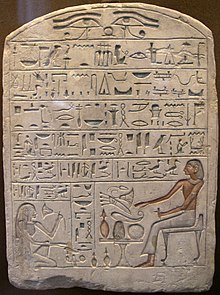
| Part of a series on |
| Ancient Egyptian religion |
|---|
 |
|
|
The offering formula, also known under transliterated forms of its incipit as the ḥtp-ḏỉ-nsw or ḥtp-ḏj-nswt formula was a conventional dedicatory formula found on ancient Egyptian funerary objects, believed to allow the deceased to partake in offerings presented to the major deities in the name of the king, or in offerings presented directly to the deceased by family members.[1][2] It is among the most common of all Middle Egyptian texts.[2]
Its incipit ḥtp-ḏj-nswt "an offering given by the king" is followed by the name of a deity and a list of offerings given. The offering formula is usually found carved or painted onto funerary stelae, false doors, coffins, and sometimes other funerary objects. Each person had their own name and titles put into the formula. The offering formula was not a royal prerogative like some of the other religious texts such as the Litany of Re, and was used by anyone who could afford to have one made.[1]
- ^ a b Collier M (1998). How to Read Egyptian Hieroglyphs. London, England: University of California Press. pp. 35–39.
- ^ a b Allen, James P. (2010). Middle Egyptian: An Introduction to the Language and Culture of Hieroglyphs (revised second ed.). Cambridge, UK: Cambridge University Press. pp. 365–367.